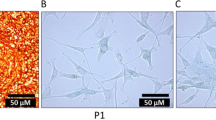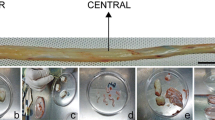Abstract
Mesenchymal stem cells (MSCs) are a group of cells present in bone marrow stroma, cord blood, Wharton’s jelly, and the stroma of various organs with the capacity for mesoderm-like cell differentiation. The aim of the present work is to isolate MSCs from human umbilical cord Wharton’s jelly and to examine the differentiation potential of these (MSCs) toward the epithelial lineage. Human MSCs derived from Wharton’s jelly of umbilical cord (≈31 cm) after a full-term delivery of 10 cases were localized and isolated and further cultured to enrich and enhance their proliferation. These MSCs were detected after an average of 21–30 days not only morphologically, as a uniform spindle fibroblast-like cells, and reached 70–80 % confluence with a good cellular yield, but also via their immunophenotypic analysis which showed positivity for CD29, CD90, CD105, and CD166 and negativity for CD34. All these cells showed 100 % negativity with CK19 to ensure the absence of any epithelial cells. Later, their differentiation potential was determined by culturing with conditioning medium that include bone morphogenetic protein-4, ascorbic acid, and human epithelium growth factor in a complete medium. These sets of conditions resulted in the expression of keratinocyte markers, namely pancytokeratin (mean value 92 %) and cytokeratin19 (mean value 74 %) using immunohistochemistry. In conclusion, these findings may have a significant impact on studies of early human epithelial differentiation, functional genomics, pharmacological testing, cell therapy, and tissue engineering by helping to eliminate worrying ethical and technical issues.






Similar content being viewed by others

References
Al-Khaldi A, Al-Sabti H, Galipeau J, Lachapelle K (2003) Therapeutic angiogenesis using autologous bone marrow stromal cells: improved blood flow in a chronic limb ischemia model. Ann Thorac Surg 75:204–209
Beyer Nardi N, da Silva Meirelles L (2006) Mesenchymal stem cells: isolation, in vitro expansion and characterization. Handb Exp Pharmacol 174:249–282
Capelli C, Gotti E, Morigi M et al (2011) Minimally manipulated whole human umbilical cord is a rich source of clinical-grade human mesenchymal stromal cells expanded in human platelet lysate. Cytotherapy 13(7):786–801
Chin SP, Poey AC, Wong CY, Chang SK, Teh W, Mohr TJ, Cheong SK (2010) Cryopreserved mesenchymal stromal cell treatment is safe and feasible for severe dilated ischemic cardiomyopathy. Cytotherapy 12:31–37
Covas DT, Siufi JLC, Silva ARL, Orellana MD (2003) Isolation and culture of umbilical vein mesenchymal stem cells. Braz J Med Biol Res 36(9):1179–1183
Dennis JE, Merriam A, Awadallah A, Yoo JU, Johnstone B, Caplan AI (1999) A quadri-potential mesenchymal progenitor cell isolated from the marrow of an adult mouse. J Bone Miner Res 14:700–709
Fong CY, Chak LL, Biswas A, Tan JH, Gauthaman K, Chan WK, Bongso A (2011) Human Wharton’s jelly stem cells have unique transcriptome profiles compared to human embryonic stem cells and other mesenchymal stem cells. Stem Cell Rev Rep 7(1):1–16
Marmotti A, Mattia S, Bruzzone M, Buttiglieri S, Risso A, Bonasia DE, Blonna D, Castoldi F, Rossi R, Zanini C, Ercole E, Defabiani E, Tarella C, Peretti GM (2012) Minced umbilical cord fragments as a source of cell for orthopaedic tissue engineering. An in vitro study. Stem Cell Int. doi:10.1155/2012/326813
Mitchell KE, Weiss ML, Mitchell BM et al (2003) Matrix cells from Wharton’s jelly form neurons and glia. Stem Cell 21(1):50–60
Montanucci P, Basta G, Pescara T et al (2011) New simple and rapid method for purification of mesenchymal stem cells from the human umbilical cord Wharton jelly. Tissue Eng Part A 17(21–22):2651–2661
Păunescu V, Deak E, Herman D, Siska IR, Tănasie G, Bunu C, Anghel S, Tatu CA, Oprea TI, Henschler R, Rüster B, Bistrian R, Seifried E (2007) In vitro differentiation of human mesenchymal stem cells to epithelial lineage. J Cell Mol Med 11(5):502–508
Sarugaser R, Lickorish D, Baksh D, Hosseini MM, Davies JE (2005) Human umbilical cord perivascular (HUCPV) cells: a source of mesenchymal progenitors. Stem Cells 23(2):220–229
Sasaki M, Abe R, Fujita Y, Ando A, Inokuma D, Shimizu H (2008) Mesenchymal stem cells are recruited into wounded skin and contribute to wound repair by transdifferentiation into multiple skin cell type. J Immunol 180(4):2581–2587
Troyer DL, Weiss ML (2008) Concise review: Wharton’s jelly-derived cells are a primitive stromal cell population. Stem Cells 26(3):591–599
Wang H-S, Hung S-C, Peng S-T et al (2004) Mesenchymal stem cells in the Wharton’s jelly of the human umbilical cord. Stem Cells 22(7):1330–1337
Weiss ML, Medicetty S, Bledsoe AR, Rachakatla RS, Choi M, Merchav S et al (2006) Human umbilical cord matrix stem cells: preliminary characterization and effect of transplantation in a rodent model of Parkinson’s disease. Stem Cells 24(3):781–792
Weiss ML, Anderson C, Medicetty S, Seshareddy KB, Weiss RJ, VanderWerff I et al (2008) Immune properties of human umbilical cord Wharton’s jelly-derived cells. Stem Cells 26(11):2865–2874
Wu M, Yang L, Liu S, Li H, Hui N, Wang F, Liu H (2006) Differentiation potential of human embryonic mesenchymal stem cells for skin-related tissue. Br J Dermatol 155(2):282–291
Wu Y, Chen L, Scott PG, Tredget EE (2007) Mesenchymal stem cells enhance wound healing through differentiation and angiogenesis. Stem Cells 25:2648–2659
Author information
Authors and Affiliations
Corresponding author
Rights and permissions
About this article
Cite this article
Bishai, I.E.M., El Ansary, M.S., Shaheen, N.M.H. et al. Mesenchymal stem cell separation from Wharton’s jelly and its differentiation into keratinocytes. Comp Clin Pathol 22, 547–553 (2013). https://doi.org/10.1007/s00580-013-1702-z
Received:
Accepted:
Published:
Issue Date:
DOI: https://doi.org/10.1007/s00580-013-1702-z



